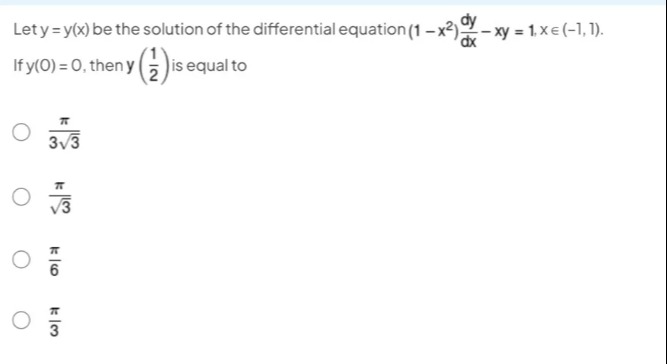Question
Question: Let y = y(x) be the solution of the differential equation $(1-x^2)\frac{dy}{dx}-xy=1, x \in (-1, 1)$...
Let y = y(x) be the solution of the differential equation (1−x2)dxdy−xy=1,x∈(−1,1). If y(0) = 0, then y(21) is equal to

33π
3π
6π
3π
33π
Solution
Given the differential equation (1−x2)dxdy−xy=1, we first rewrite it in standard linear form by dividing by 1−x2 (valid for x∈(−1,1)): dxdy−1−x2xy=1−x21.
The integrating factor μ(x) is computed as: μ(x)=exp(∫−1−x2xdx). Let u=1−x2 so that du=−2xdx. Then: ∫−1−x2xdx=21∫udu=21ln∣u∣=21ln∣1−x2∣. Thus, μ(x)=e21ln∣1−x2∣=1−x2.
Multiplying the differential equation by 1−x2 gives: 1−x2dxdy−1−x2xy=1−x21.
Notice that the left-hand side is the derivative of y1−x2: dxd(y1−x2)=1−x21.
Integrate both sides: y1−x2=∫1−x2dx=arcsinx+C.
Using the initial condition y(0)=0: 0⋅1−02=arcsin0+C⇒C=0.
Thus, the solution is: y(x)=1−x2arcsinx.
To find y(21): y(21)=1−(21)2arcsin(21)=1−416π=436π=3/2π/6=33π.
